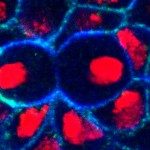Link to Pubmed [PMID] – 8742832
Dev. Genet. 1996;18(1):28-39
The thoracic integument of the adult fruit fly is a relatively simple but highly patterned structure. It is composed of sensory organ cells distributed within a monolayer of epidermal cells. Both cell types are easily detected at the cuticular surface, as each external sense organ forms a sensory bristle and each epidermal cell secretes a small nonsensory hair. Inhibitory cell-cell interactions play a key role in regulating the distribution as well as the formation of the sense organs. This review focuses on the role of these cell-cell interactions in the adoption of alternative cell fates. We also show that Notch, Hairless, and Suppressor of Hairless, three components of this intercellular signaling pathway, exhibit dose-dependent genetic interactions. Finally we address how this intercellular signaling mechanism may be modulated to result in highly reproducible outcomes.

